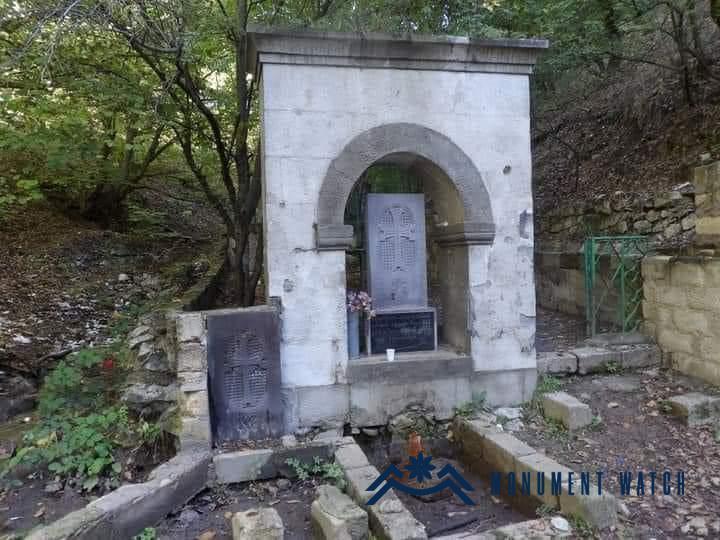
Azerbaijan destroyed the khachkar-monument located in the area called Ttu Jur of Artsakh.
Azerbaijan destroyed the khachkar-monument erected in memory of Tigran Abrahamyan and his friends, who died in the Omari mountain pass, in the area called Ttu Jur in Aghanus settlement of Kashatagh region. "Monumentwatch.org" website, which monitors Artsakh's cultural heritage, warns about this.
"As it is clearly seen from the photographs provided by the Azeri expert Varsik Simonyan, Azerbaijan destroyed the khachkar-memorial erected in memory of Tigran Abrahamyan and his friends, who died in the Omari Pass, in the area called Ttu Jur in Aghanus settlement of Kashatagh region.
Before the Azerbaijani occupation, there was a spring-monument stand, and 2 khachkars were erected in the center and next to the monument (fig. 1). And from the photo taken after the seizure of the territory, it becomes clear that the khachkars were destroyed, and the integrity of the monument was damaged and defiled with paints (fig. 2).
According to Azerbaijani news, trees were massively cut down around the historical spring near Aghanus village and a recreation area should be built in the area of the monument.
Our response
Any act of destruction of Armenian cultural values by Azerbaijan is prohibited by many conventions adopted by UNESCO and the Council of Europe, provisions of the International Court of Justice and other documents.
Disruption of the integrity of the monument-spring of the occupied Kashatagh Aghanus settlement and the destruction of khachkars are prohibited by international laws.
It is extremely important to emphasize the fact that the International Court of Justice has confirmed that the laws in force in the occupied territories, including provisions for the protection of cultural values, have acquired the status of international customary law (infra Jurisprudence), that is, they act as a universal and inescapable rule and are binding on all for states. Customary laws prohibit the willful destruction of heritage. The 38th, 39th, 40th, 41st rules of international humanitarian law refer to the protection of cultural values.
It is important to note that targeting khachkars is a particularly prohibited act and is considered a serious crime against all humanity, because "The art of Armenian khachkars. The symbolism and craftsmanship of khachkars" since 2010 has been included by UNESCO since 2003. accepted in the "List of Intangible Cultural Heritage" and is considered universal value. This means that khachkar art has an exceptional comprehensive universal value and additional international protection, and is also of great interest in the global cultural treasury.
Khachkar culture also has additional protection during and after the war. In particular, according to the 1954 Hague Convention on the Protection of Cultural Property in Armed Conflicts. additional to the convention, 1999 According to the principles of the second protocol adopted, the entire Khachkar culture has enhanced protection, and any harm done to it is, according to Article 15 point a of the protocol, a "serious violation" that can be prosecuted as a war crime in international courts.
This is documented by the 10th article of the mentioned protocol on the enhanced protection of cultural values, according to which the cultural heritage of the greatest importance for humanity should be under enhanced protection, and UNESCO, in fact, since 2010, has considered the entire Khachkari culture as such. According to Article 12 of the protocol, in the occupied territories, the state party to the protocol, namely Azerbaijan, must ensure the inviolability of cultural values under enhanced protection, refraining from making such values the object of attack or reprisals.

Add new comment